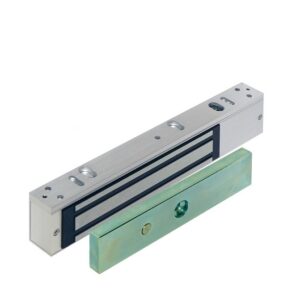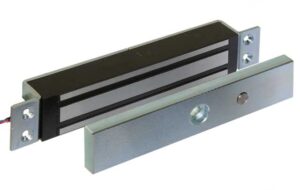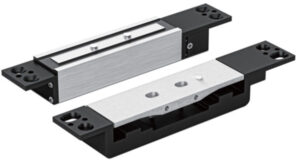Magnetic locks – often referred to as maglocks – are a popular choice for securing doors in commercial, public, and high-traffic areas. They offer reliability, speed of operation, and compatibility with access control systems, making them an effective alternative to traditional mechanical locking methods.
If fitted with an inside release button, maglocks are ideal on doors that might be used in an emergency, as they provide a good level of ‘daytime security’ yet default to an unlocked state in the event of a power cut.
As a device that relies on electro-magnetism, CE-marked maglocks will have been EMC tested to ensure they are immune to interference (EMI) from other electronic devices.
However, not all maglocks are the same. Understanding the different types – their advantages and the challenges they present – is crucial when choosing the best maglock for your situation.
Types of Magnetic Locks
Face-to-Face Maglocks

The most common type of magnetic lock is the face-to-face, or surface-mounted, maglock. These consist of an electromagnet fixed to the door frame and a steel armature plate mounted to the door. When powered, the magnet attracts the plate, creating a strong holding force.
- Advantages: Simple installation, cost-effective, suitable for a wide range of internal and external doors. Often chosen for cost-effective retrofitting.
- Limitations: Aesthetically bulky, which can restrict design choices. Not always the most secure type, although the Rutland ‘Superior’ high security model is TS.010 Grade 4 rated.
The Rutland Face Fixed Electro-Magnetic (EM) Lock offers many advantages as standard;
- Dual voltage 12/24V DC (selectable on site)
- Safety bolts prevent the magnet from detaching
- Suitable for single or double doors, inward or outward opening
- Fire rated within approved Timber and Steel Doors to EN 1634-1 for 30 & 60 mins
- Available in 3 sizes, from 2660N to 6227N of holding force.
Morticed Maglocks

Morticed maglocks are recessed into the door and frame, making them less obtrusive. They function similarly to face-to-face units but are designed to integrate within the door structure.
- Advantages: Neater appearance, more tamper-resistant, ideal for projects where visual impact is essential.
- Limitations: More complex installation, requiring precise cutting of the door and frame. Retrofitting can be challenging.
The Rutland Mortice electro-magnetic locks are mounted in a frame with the armature plate either in or on the door, and are factory-fitted to ensure alignment and maximum holding force.
- Available in TS.010 Grades 2 and 3.
- Dual voltage 12/24V DC (selectable on site)
- Suitable for inward or outward opening doors
- Concealable within the door leaf.
Shear Type Maglocks

Shear locks operate differently from standard face-to-face maglocks. Instead of the magnet and armature clamping together directly, they lock in shear – the plate slides into position, engaging with the electromagnet to create both vertical and horizontal holding forces.
- Advantages: Provide a flush, concealed finish with strong holding force. Suitable for higher-security applications, as the shear force copes better with shock force.
- Limitations: Require highly accurate installation and alignment. Any misalignment can reduce effectiveness, so it is best to choose one that is supplied ready assembled, or comes pre-fitted into the doorset.
Shear Mag Locks such as the Rutland REM1200SHEAR provide a high locking force of 2400 lbf (1,675N). Being embedded within the door frame, they are protected from tampering when the door is locked.
The Problem of Residual Magnetism
While maglocks are generally reliable, one common concern is residual magnetism. After the lock is de-energised, a small magnetic field can remain in the armature plate. This can delay the plate from fully releasing, meaning the door may feel “stuck” even though it should be unlocked. In environments where a smooth, safe exit is essential – such as schools, hospitals, or public buildings – this can present a negative user experience.
How the Rutland Maglock Solves It
The Rutland Electro-magnetic Locks overcome this problem with a Push-Off button fitted in the armature plate, which forces the plate away from the magnetism when the power is cut, ensuring a smooth release every time. This makes them particularly well-suited for emergency exit routes, particularly if part of an EN 13637 Electrically Controlled Exit System, and high-traffic doors where both security and safety are critical. The Rutland solution combines the holding strength of a traditional maglock with guaranteed release performance, removing one of the biggest frustrations associated with electromagnetic locking.
Locked – but is the door shut?
Some remotely triggered locks can be activated before the door fully closes, resulting in an open door when the system appears secure. Mag locks get around this problem by their operating principle.
For definitive feedback on door lock status, the range of Rutland Maglocks provides signal monitoring, allowing a warning light or alarm to be activated whenever the door is open.
Conclusion
Magnetic locks remain a key component in modern access control strategies. Choosing the right type – whether face-to-face, morticed, or shear – depends on the specific security, design, and installation requirements of a project. However, specifiers and installers must also be aware of operational and installation challenges such as residual magnetism, lack of header space to fix to, and aesthetics. With solutions like the Rutland maglock, it is possible to achieve reliable holding power without compromising safety, design, security, and ensuring doors always release cleanly and hold securely when required.
